The tree porcupine is one of the largest rodents in North America. They are distributed throughout Canada and much of America.
In general, porcupines are non threatening and some would say, even cute. But they can cause extensive damage to trees, wood furniture, sheds, homes and pretty much anything in the yard made of wood including your house!
PORCUPINE BIOLOGY
The tree porcupine is a heavy, stout animal growing to be 10-20 lbs or even larger. Their entire body is covered with quills which can number over 20,000. Only the face, under body and under the tail will remain quill free.
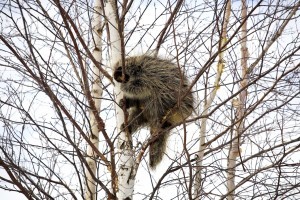 Although quills can dislodge easily, porcupines cannot “throw” them at will. They generally take a defensive stand daring predators to bite knowing their quills will protect them. In some cases, they may lunge, but porcupines are not swift nor do they pretend to be. If you get too close, they may slap their tail, but in general will leave you alone unless antagonized. Their quills are a problem for animals which are stuck and don’t receive medical attention. Such areas will get infected quickly and such infections will lead to many types of disease.
Although quills can dislodge easily, porcupines cannot “throw” them at will. They generally take a defensive stand daring predators to bite knowing their quills will protect them. In some cases, they may lunge, but porcupines are not swift nor do they pretend to be. If you get too close, they may slap their tail, but in general will leave you alone unless antagonized. Their quills are a problem for animals which are stuck and don’t receive medical attention. Such areas will get infected quickly and such infections will lead to many types of disease.
In the wild, many animals which receive quills in their mouth are unable to eat and will eventually starve. Dogs which try to bite will find out porcupines aren’t good eating but only a few seem to learn from their experience. Most which get a mouthful don’t seem to learn. It’s not unusual to see them back at the vet time after time for the same treatment following a bite.
Porcupines have one litter in the spring. They almost always have one young and twins are very rare. Their gestation is long for a rodent (about seven months). Young porcupines can walk almost immediately and will climb trees within two days. At ten days, most are on their own. By their second year, they’re able to reproduce.
PORCUPINES CAUSE DAMAGE!
Although porcupines are great tree climbers and can live on several species of trees, they seem to prefer, white, birch, ponderosa, pinion, hemlock, spruce, elm and poplar. When living in the woods and feeding on wild trees, porcupines go unnoticed. Since they do most of their feeding at night, many people aren’t aware of how many may be living around their homes. But this is rapidly changing as they conflict more and more with man.
PORCUPINE TREE DAMAGE
As homes are built in wild areas with strong populations of animals including porcupine, conflict between them and man is inevitable. If you are finding damage on your property, you will need to act. Porcupines are creatures of habit and will use the same feeding runs night after night.
More importantly, the kind of damage they typically do to a tree is significant and will quickly cause stress making it vulnerable to disease. If you have a stand of trees you are particularly fond of and want to assess the damage being done, use STRESS GLASSES to monitor their status. These unique eye glasses enable you to “see” the health of trees, turf and or shrubs that are under stress. They can really help you locate, treat and save trees which are under attack before it’s too late to save them.
PORCUPINES WILL EAT ANYTHING MADE WITH WOOD
Porcupine damage to homes, structures and garden areas is on the rise. Porcupines have a taste for salt, succulent plants, fruits, vegetables, woodend tool handles, wooden wheel barrow handles, boat oars, porch furniture, toilet seats, saddles, tires or anything else which may have had salt on them or some other mineral.
Wooden tool handles absorb salt from sweat which is certain to attract feeding porcupines. Automobile tires which travel on salted roads in the winter will be absorbing a lot of this mineral which will lure porcupines to feed on the tasty tread.
Saddles used by equestrians are certain to be eaten if left within range. T-111 wood siding, plywood and pressboard all use a laminate glue which porcupines love! They will eat it till nothing is left. As much as you replace they will consume. Tree houses, hunting stands, out houses, sheds, barns, wood shops: if it’s made of wood they will find it and start feeding!
WHAT DO PORCUPINES EAT?
Because porcupines primarily target wood, most people are unaware how much they like succulent plants. Porcupines love rose bushes, pansies, lily pads, all types of berries, corn, and several other garden favorites. Rabbits and deer are often blamed for this damage when many times it is being done by porcupines. Since they are mostly nocturnal, they are able to go about their business undetected but if you notice a lot of shavings or “frass” under a newly damaged tree, it could be from a porcupine. Here is frass seen around a beach tree a porcupine has targeted for dinner.
HOW TO CONTROL PORCUPINE DAMAGE
Porcupine control is done in one of two ways. Once you find activity, it is important to stop it early. Porcupines will travel several miles for a meal, but once they find a good place to feed, they will eat everything available before they move on. Because of this pattern, you must nip new damage and force them to move or else it will just continue on and one. This can be done by either removing the food they want to feed on or by making it taste terrible so they simply leave it alone. Tools, yard furniture and small wooden objects can usually be removed so porcupines will not have access to them. But structures and trees which are permanent present a challenge when repelling porcupines.
BEST PORCUPINE REPELLENT SPRAY
The sides of buildings, sheds, large wooden furniture and other large objects not easy to move can be treated with PEST AWAY.
This liquid repellent is all natural, made with essential oils and to porcupines, its repulsive. Just mix up 2 oz of concentrate with a gallon of water and spray the surface of anything the porcupine wants to eat and it will stop.
Pest Away treatments will last 3-4 weeks per application and can withstand normal rainfall. Generally, one application will force the porcupine to find another food supply so it will cease coming around but we recommend treating at least twice to ensure they’re gone for good.
Pest Away can be sprayed on plants too as well as where they’re walking, tracking, etc. The 8 oz jar makes 4 gallons of spray and each gallon will cover up to 800 sq/ft.
You’ll need a good PUMP SPRAYER to apply the Pest Away.

LIVE TRAPPING PORCUPINES
Ultimately, live trapping porcupines is one sure way to control the problem for good. And its easy. All you need to is to know where they’re active. Once you find damage on your building, garden or other areas in the yard, set the trap where they are feeding.
Use a LT111230RD which is plenty big for any porcupine. Use apples covered with salt for a quick catch. Cut the apple up into 8 pieces and then place 2 outside the trap, 2 pieces just inside and then the other 4 pieces behind the trip pan. Be sure to use a lot of salt over the freshly cut apples. The moisture of the apple will keep the salt attached to the fruit.
When your nuisance porcupine comes around for their daily meal, they won’t be able to resist your tasty offering. If you intend on relocating the animal, you’ll need to take it at least 20 miles away. Porcupines are used to traveling many miles to find food and their “GPS” skills are quite good. If you suspect a recently trapped animal has returned, you will be able to catch it again and take it at least 30 miles away to insure it won’t return.
SOUND REPELLER FOR PORCUPINES
Lastly, one of the easiest ways to prevent porcupines from coming around is to install SOUND REPELLERS aimed at the wood or trees they target. Our unit features several settings making it ideally suited for keeping porcupines out of the yard.
For open areas, it will protect up to 5,000 sq/ft. Like a flashlight, the sound will project in the direction the unit is pointed so place units at points of entry on your property or at the targeted tree or structure they’re eating.
Our unit can be set to operate at night, day or both. For porcupines, you’ll want to set it for “night”.
This short video (less than 60 seconds long) shows how our Ultra Sound Repeller works:

Next, you’ll want it to activate when it senses motion so set this switch to “motion”. Below this setting is the sensitivity setting for the motion detector. In general, you’ll want this set all the way up to “30”. This means it will turn on when animals are within 30 feet of the unit although it could off when they’re within 40 feet depending on visibility.
Next, you’ll want to set the audible sound as high as you can. In general, 60-80 is high enough. The LED Bar will go off automatically as will the Ultra Sound. The audible sound does not need to be on but for porcupine, keeping it active is best.
Lastly, turn the yellow button frequency setting almost all the way to the left for porcupine.
These settings are detailed on our product page here: PORCUPINE SOUND SETTINGS
You’ll also need 4 “C” cell batteries to power it; the unit will turn on when the target animal walks into the motion detector range and will sound for 20 seconds. During this time the porcupine will leave and after 1-2 experiences with this machine, learn to stay away.
Batteries will last 3-6 months if not longer. Also included is an optional AC power supply and a remote control so you can disarm the unit anytime. When set to “night”, it will only go off after dark so you will not hear it during the day. But at night, if you wanted to walk within the range of the unit, use the wireless remote to disarm it so you can walk around it without setting it off.
Plan on keeping the unit about 2 feet off the ground though it can be just 1 foot high or up to 4 feet up. But for porcupine, 2 feet is ideal.
Since porcupines tend to target one area at a time, it usually only takes one machine to keep them away but you may want to protect more areas in the yard or home since they can be used to deter a range of animals.
comes with an AC Adaptor and can be set to be “on” continuously. Use this setting for initial placements until you’re sure nothing is active. The sounds won’t hurt them or other animals but its annoying and “scary” to animals who don’t live on the property. One machine can cover up to 3,500 sq/ft of open area and they should be placed 3-5 feet up off the ground to allow sound waves open air channels.
Units should be placed 2-3 feet above ground and pointed in the direction where animals are entering as well as “over” the turf you want to protect. 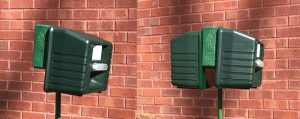
Mounting Blocks allow you to place units anywhere and they will save time too.
We also feature several accessories for our sound repeller including POWER CORD EXTENDERS (33 FEET AND 66 FEET), CIGARETTE LIGHTER POWER ADAPTER, ALLIGATOR CLIP POWER CORD and AC POWER SUPPLY REPLACEMENTS.
Porcupines are best known for their problematic quills and though not perceived to be a threat around the home, they can cause a lot of damage in the yard. If you have a nuisance porcupine chewing up your tires, trees, outside furniture or yard tools, try Pest Rid spray to stop them. If this doesn’t work, live trap them or install some Yard Gards.
CONTACT US
Give us a call if you need further help. Our toll free is 1-800-877-7290 and we’re open Monday through Friday, 9:00 AM to 4:00 PM. On Saturday, 9:00 AM to 2:00 PM (Eastern Standard Time).
Email questions here: https://bugspray.com/about-us/contact-us
Order online and get a 5% discount! We ship fast with 99.9% of all orders shipping within 1 business day!!
Learn more about BUGSPRAY.COM and why it’s never been easier or safer to do your own pest control.
Please show your support for our business by purchasing the items we recommend from the links provided. Remember, this is the only way we can stay around to answer your questions and keep this valuable web site up and running. Thanks for your business!
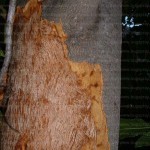

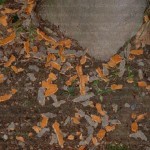
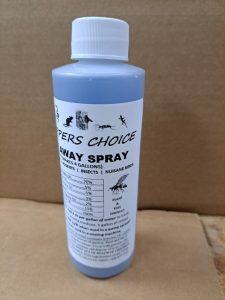

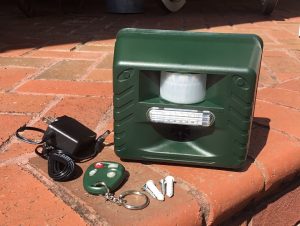

Carol Leavitt says
Where do I get Ropel to try and get rid of Porcupine’s that are eating at the siding on my garage?
Tech Support says
Links to all our products are listed above in the article.
And here is the one for Ropel in our shopping cart. Please show your support for our business by purchasing the items we recommend from the links provided. Remember, this is the only way we can stay around and keep this valuable web site up and running. Thanks for your business!
Ropel Liquid: https://bugspray.com/repellents/liquid/ropel-liquid
Lisa Landry says
moles burrowing just under the lawn, making it spongy also barn FULL of porcupines, chewing on Everything in there,and lastly mice/rats in my cellar, what can I do to KILL them, I’ve been fighting for years and I’m so TIRED… Thank you.
Tech Support says
If you scroll “up”, you will see our article detailing what you need for the porcupines. In most all cases, our sound repellers would do the job and should do fine for this situation.
For the moles, our “in the ground solar repellers” combined with our gas sticks will get rid of them for good. Details on these products and how to use them are in our Mole article here:
Mole Control: https://www.bugspray.com/articles98/moles.html